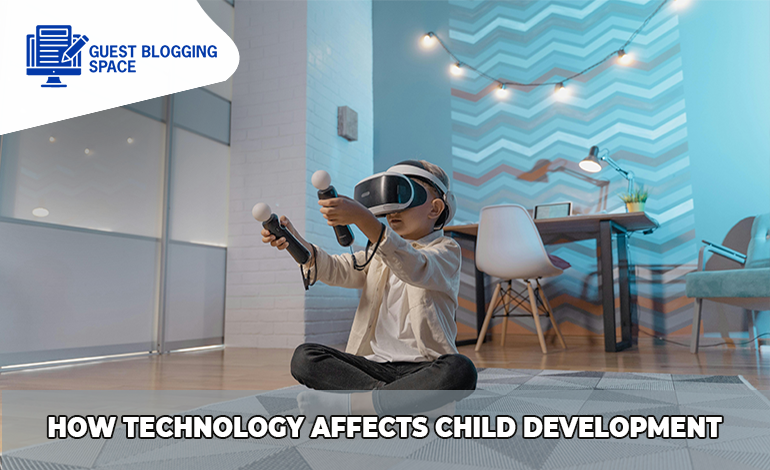How Technology Affects Child Development (2025 Guide)

How Technology Affects Child Development is one of the most significant forces shaping the future of our children. In today’s digital age, technology isn’t just a tool—it’s a constant presence in their lives, influencing everything from how they learn to how they connect with others. With educational apps, online games, and social media, technology has become a powerful catalyst for growth, creativity, and social interaction. While it opens up endless opportunities for learning, it also brings new challenges. The way children engage with the world around them today will define their emotional and cognitive development tomorrow. It’s essential to understand how this technological influence shapes their minds and hearts, guiding them on their journey of growth and discovery.
Overview of Technology’s Role in Children’s Lives
From educational apps to social media platforms, technology offers diverse opportunities for engagement. It supports learning through interactive tools and connects children globally. However, excessive use raises concerns about physical and mental health.
Statistics on Technology Usage
Recent studies indicate significant shifts in children’s screen time. Traditional television viewing is declining, while gaming and short-form videos are on the rise. Notably, 40% of 2-year-olds own tablets, and a quarter of 8-year-olds have smartphones. These trends highlight the pervasive nature of technology in young lives.
The Importance of Balancing Tech Use
While technology offers educational benefits, balancing its use is crucial. Excessive screen time has been linked to manic symptoms in pre-teens, including inflated self-esteem and decreased need for sleep. Experts recommend setting digital boundaries and promoting offline activities to ensure healthy development.
The Digital Divide
Access to technology is not uniform, creating disparities known as the digital divide. In South Asia, 88% of school-age children lack internet access at home, limiting educational opportunities. This gap perpetuates inequalities, as children from wealthier households are more likely to be connected.
Addressing this divide requires investment in digital infrastructure and policies promoting equitable access. Ensuring all children can benefit from technological advancements is essential for fostering an inclusive digital future.
The Positive Impact of Technology on Children
Educational Benefits
Digital tools offer personalized learning experiences, enhancing children’s Education. Platforms like Khan Academy and Duolingo cater to various learning styles, making complex concepts more accessible. Virtual field trips and cultural exchanges help children connect globally, enriching their understanding of the world.
Development of Digital Literacy
Introducing technology early equips children with essential digital skills. Educational apps and games improve problem-solving and critical thinking. This early exposure fosters digital literacy, preparing them for future challenges. It also enhances their ability to evaluate online content critically.
Health & Communication
Digital health tools, such as telemedicine and health apps, monitor children’s well-being effectively. Technology enables children to maintain relationships with family and friends, fostering social skills. Online therapy services and peer support groups address mental health challenges, providing accessible support.
Incorporating technology thoughtfully supports children’s development across education, digital skills, and health. Balanced use enhances learning, prepares them for a digital future, and maintains well-being.
Overuse & Screen Time Concerns
- Physical & Mental Health Risks: Extended screen exposure can lead to eye strain, disrupted sleep, and posture issues.
- Sedentary Lifestyles: Prolonged screen time often replaces physical activity, contributing to obesity.
- Reduced Attention Span: Fast-paced digital content may impair children’s ability to focus on less stimulating tasks.
Social & Emotional Development
- Impeded Face-to-Face Interaction: Excessive screen time can hinder the development of social skills and reduce in-person communication.
- Cyberbullying & Online Dangers: Children may encounter inappropriate content and bullying online, leading to emotional distress.
- Emotional Regulation Challenges: Overexposure to digital media can affect children’s ability to manage emotions effectively.
Addiction & Dependency
- Technology Addiction: Signs include excessive gaming or social media use, leading to neglect of offline activities.
- Impact on Academic Performance: Addiction can result in declining grades and diminished school motivation.
Behavioral Problems
- Aggression & Impulsivity: Exposure to violent content may increase aggression and impulsive behaviors.
- Setting Healthy Boundaries: Establishing screen-time limits is crucial for maintaining a balanced lifestyle.
- Role of Parents: Parents should monitor technology use and promote healthy habits. AP News
Addressing these issues requires a collaborative effort from parents, educators, and policymakers to ensure technology benefits children’s development while minimizing potential harms.
Setting Screen Time Limits
Establish age-appropriate screen time guidelines. The American Academy of Pediatrics recommends no more than one hour daily for children aged 2 to 5. For older children, ensure technology use doesn’t interfere with sleep, physical activity, or other essential behaviors.
Utilize apps and device settings to monitor and control screen time. Tools like parental controls and screen time trackers help enforce boundaries.
Promote purposeful technology use by co-viewing content and discussing online activities. This approach fosters understanding and guides appropriate digital engagement.
Encouraging Healthy Tech Habits
Balance screen time with physical activities. Encouraging outdoor play and exercise supports physical health and counters sedentary behavior.
Organize tech-free family activities, such as board games or outdoor outings, to strengthen personal interactions and create lasting memories.
Model positive tech behavior by demonstrating balanced device use. Children often emulate adult habits, so setting a good example is crucial.
Monitoring Content & Online Safety
Stay informed about your child’s online interactions. Regularly discuss the content they access and the platforms they use to ensure age-appropriate exposure.
Educate your child on online safety, including the importance of privacy settings, recognizing cyberbullying, and understanding the potential risks of sharing personal information.
Implement parental controls to filter inappropriate content and set boundaries for safe online experiences. Utilizing device settings and third-party apps can assist in creating a secure digital environment.
By actively managing technology use, parents can support healthy child development in the digital age.
Balancing Technology and Traditional Learning
Integrating Technology in Education
Educators and parents can collaborate to incorporate technology into children’s education meaningfully. Combining digital tools with traditional methods enriches learning experiences. Ensuring equitable access to technology addresses the digital divide, allowing all children to benefit from digital education.
Encouraging Creativity & Problem Solving
Technology stimulates creative thinking by providing educational tools that encourage independent thought. Educational apps and games foster creativity, logic, and problem-solving skills. Resources designed to develop critical thinking enhance logical reasoning and analytical abilities in children.
Integrating technology into education offers numerous benefits, including personalized learning experiences and enhanced cognitive development. However, it’s essential to balance digital and traditional learning methods to promote holistic growth. Parental involvement and equitable access to technology play crucial roles in this balanced approach.
Emerging Technologies and Their Potential Impact on Children
Emerging technologies, notably Artificial Intelligence (AI), Robotics, Virtual Reality (VR), and Augmented Reality (AR), are profoundly influencing child development, particularly in educational contexts.
AI and Robotics in Education
- AI-Driven Learning: AI tailors educational content to each child’s learning pace and style, enhancing engagement and comprehension.
- Introduction to Coding & Robotics: Introducing coding and robotics fosters problem-solving skills and prepares children for future technological landscapes.
- Personalized Learning Paths: AI-powered platforms adapt lessons based on individual progress, ensuring effective learning experiences.
Virtual Reality (VR) and Augmented Reality (AR)
- Immersive Learning Experiences: VR and AR transform abstract concepts into interactive experiences, making learning more engaging.
- Empathy & Perspective-Building: These technologies enable children to experience diverse cultures and perspectives, enhancing empathy.
- Therapeutic Applications: VR and AR offer controlled environments for children with special needs to practice social skills and receive personalized feedback.
Integrating these technologies into education supports cognitive, emotional, and social development, preparing children for a technology-driven future.
Final Thoughts
Summarizing the Importance of Balance
Integrating technology into children’s lives offers educational benefits but also poses risks. Excessive screen time can lead to physical health issues, such as obesity and sleep disturbances. It can also hinder cognitive development, affecting attention span and academic performance. Moreover, overuse of digital devices may impair social skills and emotional well-being. Understanding How Technology Affects Child Development is crucial in balancing its positive and negative impacts.
Staying Informed as a Parent
Parents should stay informed about the latest technology trends and their potential impacts on child development, especially when considering how technology affects child development. Understanding how excessive screen time affects physical health, cognitive abilities, and social skills enables parents to set appropriate boundaries. Engaging with educational content and monitoring device usage can help mitigate risks. Active involvement in children’s digital lives fosters healthy technology habits.
Proactive Engagement with Future Technologies
Exploring emerging technologies can enhance children’s learning experiences. Interactive educational tools and resources provide personalized learning opportunities. However, it’s essential to balance screen time with activities like outdoor play and reading. Setting clear guidelines and encouraging diverse interests support holistic development. Promoting digital literacy equips children to navigate technology responsibly.
FAQs
How much screen time is recommended for children?
The American Academy of Pediatrics suggests limiting screen time to one hour daily for children aged 2 to 5.
How can I make technology educational for my child?
Utilize educational apps and interactive content to enhance learning experiences through technology.
What are the signs of technology addiction in children?
Indicators include mood swings, anxiety, withdrawal, poor sleep, and reduced interest in offline activities.
How does technology impact a child’s development?
Excessive screen time can affect cognitive functions, attention span, and social-emotional skills.
What are 5 negative effects of technology on children?
These include reduced attention span, sleep disturbances, obesity, impaired social skills, and mental health issues.
How does technology affect kids emotionally?
Overuse can lead to anxiety, depression, and decreased emotional intelligence due to limited face-to-face interactions.
How does screen time affect a child’s development?
Excessive screen time may cause delays in language development, attention issues, and academic challenges.
What are the most significant disadvantages of technology in childhood?
Major drawbacks include physical health risks, cognitive delays, social isolation, and exposure to inappropriate content.
How can I promote healthy digital habits in my child?
Set clear screen time limits, encourage offline activities, and model balanced technology use.
What role do schools play in managing children’s technology use?
Schools should educate on responsible tech use, set usage guidelines, and promote digital citizenship.
Don’t Let This Opportunity Slip Away!
Technology significantly influences children’s development, offering both advantages and challenges. For instance, educational apps and games enhance learning and problem-solving skills, making education not only more engaging but also more effective. However, excessive screen time can lead to shorter attention spans and multitasking tendencies, which, in turn, affect focus. Moreover, digital platforms facilitate communication, connecting children with peers globally and fostering empathy. Yet, over-reliance on digital communication may, in some cases, hinder face-to-face interaction skills. Furthermore, prolonged screen exposure contributes to a sedentary lifestyle, which can potentially lead to obesity and posture issues.
Moreover, blue light from screens can disrupt sleep patterns, consequently leading to sleep deprivation. Additionally, social media’s constant comparison can negatively impact mental health, thereby increasing anxiety and depression risks. Therefore, balancing technology use with physical activity and offline interactions is essential for healthy development. Furthermore, parental involvement and setting boundaries can help mitigate the risks associated with excessive technology use. Ultimately, understanding how technology affects child development is key to making informed decisions. By managing technology use effectively, we can promote positive outcomes for children’s development while minimizing potential harm.
Share Your Thoughts:
How Technology Affects Child Development is a topic that has been widely discussed in recent years. As children are exposed to technology at an increasingly young age, there is growing concern among parents and educators about the impact it may have on their cognitive, social, and emotional development. From smartphones and tablets to computers and video games, technology is an ever-present part of modern life, and understanding how it influences child development is crucial for parents and caregivers.









